Consultation notice
Potential regulatory amendments to the Valuation for Duty Regulations
Current status: Closed
Opened on and will close on .
The CBSA is giving an opportunity to interested stakeholders to send comments and questions on policy directions, which could potentially inform future regulatory amendments to the Valuation for Duty Regulations.
We welcome feedback from:
- importers
- Canadian retailers
- brokers
- any other interested stakeholders
Context of consultations
Budget 2021 proposed changes to the Customs Act to improve duty and tax collection, by ensuring that goods are valued in a fair and consistent manner by all importers as a means to level the playing field between domestic and foreign businesses.
Bill C-30, Budget Implementation Act, 2021, No.1, introduced on , includes a legislative amendment to subsection 45(1) of the Customs Act. This amendment introduces a definition of the term "sold for export to Canada", and allows its meaning to be assigned by the regulations.
Below is a summary of elements being considered by the CBSA for potential future regulatory amendments and for which these consultations are conducted.
Measures under consideration
1. Define the scope of "sold for export to Canada" to specify the relevant transaction for export which forms the basis of the transaction value of the goods.
This proposal would ensure that the value for duty of imported goods determined under the transaction value method is based on the sale that causes the goods to be exported to Canada, i.e. the last transaction in the commercial chain, irrespective of the chronological order of the sales. Under the proposal, the term "sale" would be constructed in a broad sense, which would include any type of arrangements that cause the goods to be exported to Canada.
2. Clarify the definition of "purchaser in Canada", as well as the associated definitions of "resident" and "permanent establishment", and ensure the relevant sale for export forms the basis of the transaction value of the goods.
The intent of these proposals is to remove any ambiguity on how to qualify as a permanent establishment. To qualify, the person would need to:
- be the purchaser of the goods imported to Canada
- have a fixed place of business in Canada, through which the goods are purchased
and - have the authority to enter into the arrangement/sale (the permanent establishment could not, under this proposal, be a conduit in the sale)
A non-resident importer, who does not have a permanent establishment, would only qualify as a purchaser in Canada if the goods were imported:
- for their own use
or - on speculation of future sales (meaning the sale of the goods to a person in Canada was not arranged in any way before the goods arrived in Canada)
Please refer to the Annex for illustrative examples of the relevant sale for export where a series of sales occur in respect of the goods.
Contact information
Please submit any questions or comments by email:
Edith Laflamme
Trade Policy Division
Trade and Anti-dumping Programs Directorate
Canada Border Services Agency
cbsa.vfd_consultation-consultation_ved.asfc@cbsa-asfc.gc.ca
Related links
- Information about Valuation
- Customs Valuation Handbook: How to establish the value for duty of imported goods
Annex: Relevant sale for export to a purchaser in Canada: A series of sales scenarios
The following examples illustrate the relevant sale for export to Canada to a purchaser in Canada (i.e. last sale, including any type of arrangement) for determining the transaction value under section 48 of the Customs Act where the goods are subject to more than one sale prior to the importation of the goods into Canada (a series of sales). Please note, information on who acts as the importer of record or who holds title of the goods at the time of importation is generally not provided in these examples because this is not considered determinative of the relevant sale for export to Canada.
Example 1
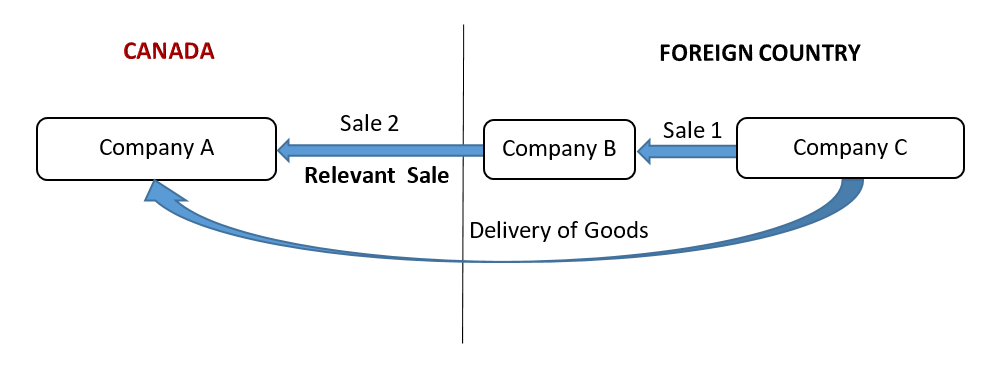
Company A, a resident in Canada, orders goods from company B, located in a foreign country. Company B then contracts with company C, also located in the foreign country, to fill the order. The goods are shipped directly from company C to Canadian company A. In this case, the goods are the subject of two sales:
- sale 1: from company C to company B
and - sale 2: from company B to company A
Both sales occur prior to importation. Sale 1 does not involve a purchaser in Canada. Sale 2, from company B to company A, is to a purchaser in Canada since company A is a resident. Sale 2 is also the sale that causes the goods to be exported to Canada. Therefore, it is considered the relevant sale for export to Canada to a purchaser in Canada and is to be used to determine the transaction value of the goods.
Example 2
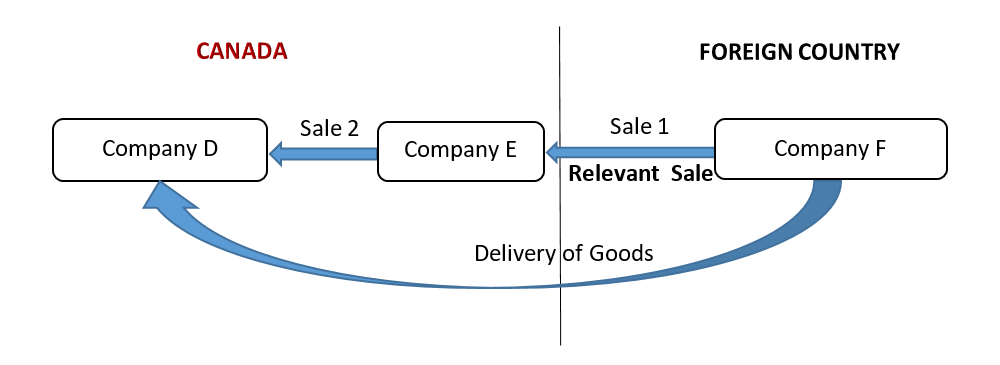
Company D, located in Canada, orders goods from company E, also located in Canada. Company E contracts with company F, located in a foreign country, to fill the order. The goods are shipped directly from company F to company D. In this case, the goods are the subject of two sales:
- sale 1: from company F to company E
and - sale 2: from company E to company D
Company D is a Canadian resident and company E qualifies as a permanent establishment. Therefore, both sales occur prior to importation and are made to persons that qualify as a "purchaser in Canada". Sale 2, from company E to company D, is between a resident and a permanent establishment and, as such, is not a sale for export to Canada. Therefore, the relevant sale for export to a purchaser in Canada is the sale from company F to company E, and is to be used for determining the transaction value of the imported goods.
Example 3
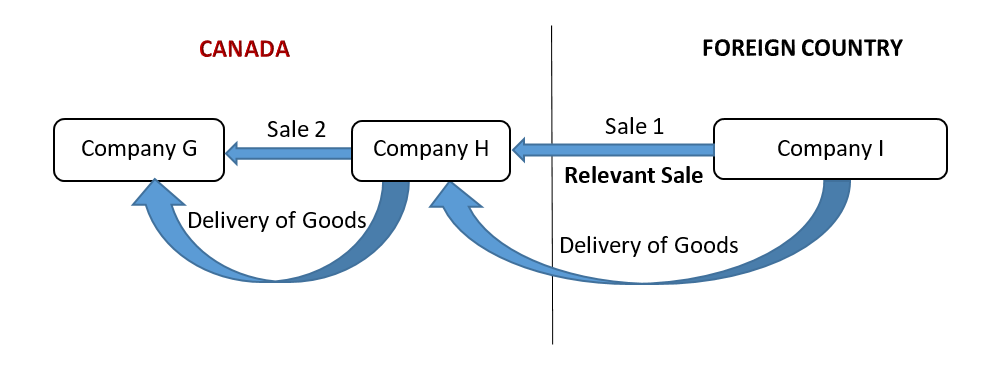
Company H, a resident in Canada, purchases goods from company I, located in a foreign country. The goods are shipped to company H's warehouse in Canada. Following the importation of the goods, company H sells the goods to company G, a resident in Canada. In this case, the goods are the subject of two sales:
- sale 1: from company I to company H
and - sale 2: from company H to company G
The only sale that occurred prior to the importation of the goods into Canada is sale 1, from company I to company H. It involves a purchaser in Canada and it is this sale that causes the goods to be exported to Canada. Therefore, sale 1 is the sale for export to Canada to a purchaser in Canada that is to be used to determine the transaction value of the imported goods.
Example 4
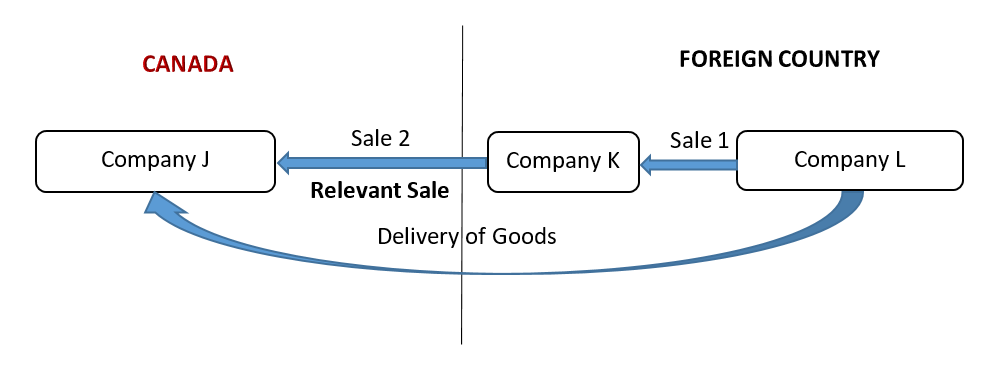
Company J, who is located in Canada and qualifies as a permanent establishment, enters into an agreement to purchase goods from company K, located in a foreign country. Company K then contracts with company L, also located in the foreign country, to fill the order. The goods are shipped directly from company L to company J in Canada. In this case, the goods are the subject of two possible sales:
- sale 1: from company L to company K
and - sale 2: agreement to sell between company K and company J
Both sale 1 and the agreement to sell (sale 2) occur prior to importation. Company K does not qualify as a purchaser in Canada, as it is a non-resident who has an agreement to sell goods to a person in Canada. The agreement between company K to company J is considered a sale for export and is to a purchaser in Canada, as company J qualifies as a permanent establishment. It is also this agreement that causes the goods to be exported to Canada. Therefore, it is sale 2, the agreement between company K and company J, that is to be used to determine the transaction value of the imported goods.
Example 5
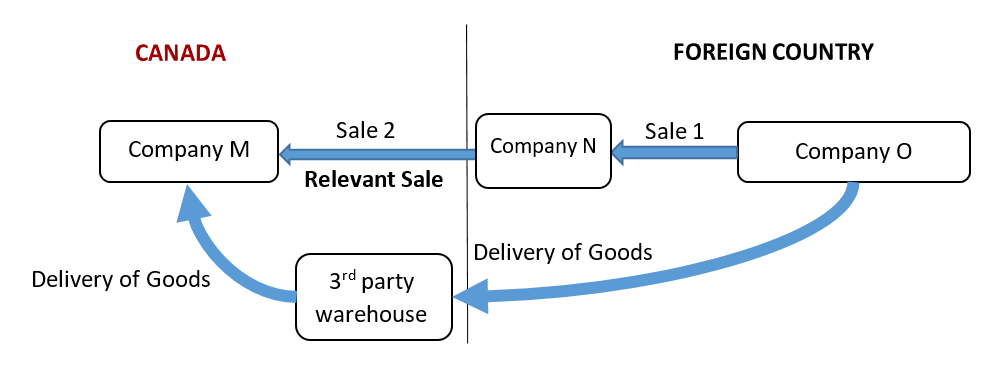
Company M, who is a resident in Canada, places a blanket purchase order for goods with company N, located in a foreign country. Company N then places an order for the goods with company O, also located in the foreign country. The goods are first shipped to a third-party warehouse, located in Canada, and then to company M, also located in Canada. In this case, the goods are the subject of two possible sales:
- sale 1: from company O to company N
and - sale 2: agreement (blanket purchase order) between company N and company M
Both sale 1 and the blanket order (sale 2) occur prior to importation. Company N does not qualify as a purchaser in Canada, as it is a non-resident who has an agreement, the blanket purchaser order, with a resident in Canada. The agreement between company N and company M is considered a sale for export and is to a purchaser in Canada, as company M is a resident. It is also this agreement that causes the goods to be exported to Canada. Therefore, it is sale 2, the agreement between company N and company M, that is to be used to determine the transaction value of the imported goods.
Example 6
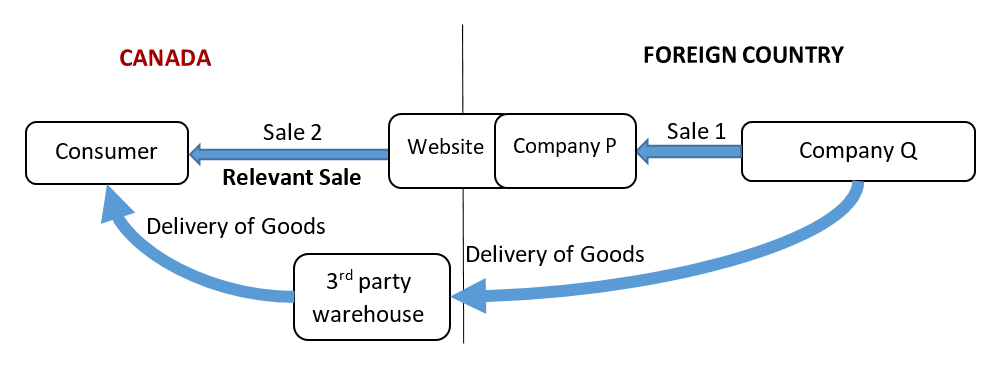
A consumer in Canada places an order online through company P's website and pays for the goods. Company P, located in a foreign country, then places an order with company Q, also located in the foreign country, to fill the order. The goods are shipped by company Q, through a 3rd party warehouse located in Canada, to the consumer in Canada. In this case, the goods are the subject of two sales:
- sale 1: from company Q to company P
and - sale 2: from company P to the consumer
Both sales occur prior to importation. Company P does not qualify as a purchaser in Canada, as it is a non-resident who has sold the goods to a person in Canada. Sale 2, from company P to the Canadian consumer, is to a purchaser in Canada, as the consumer is a resident. It is also the sale that causes the goods to be exported to Canada. Therefore, sale 2, from company P to the consumer, is considered the relevant sale for export to Canada and is to be used to determine the transaction value of the imported goods.
Example 7
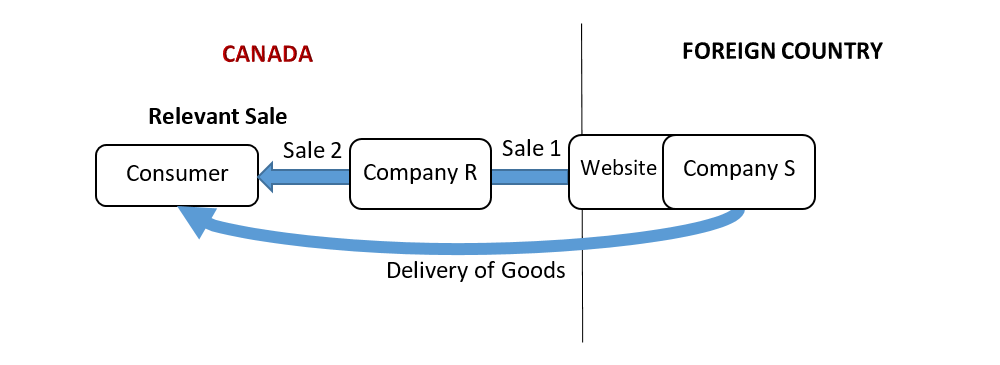
A consumer in Canada places an order online and pays for goods through the website of company S, who is located in a foreign country. The website through which the order is placed is set up to represent company S's related company R, a Canadian entity, to sell goods in Canada. The order placed through the website automatically generates two invoices at the same time: one from company S to its related company, company R, and another from company R to the consumer. Company S fills the order and ships the goods directly to the consumer. Company R pays company S for the goods and also pays company S a fee for online services.
In this case, the goods are the subject of two possible sales:
- sale 1: from company S to company R
and - sale 2: from company S, through company R, to the consumer
Both sales occur prior to importation. The order from the consumer sets off the chain of events that cause the goods to be exported to Canada. Company R does not order or purchase the goods on its own account. Therefore, in the scenario under consideration, it does not qualify as a purchaser in Canada. The sale from company S, through company R, to the consumer is to a purchaser in Canada, as the consumer is a resident who ordered and purchased the goods on their own account, and it is the sale that caused the goods to be exported to Canada. Therefore, it is the sale from company S, through company R, to the consumer that is considered the relevant sale for export to Canada to a purchaser in Canada and it is the price to the Canadian consumer that is to be used as the basis to determine the transaction value of the imported goods.
Example 8
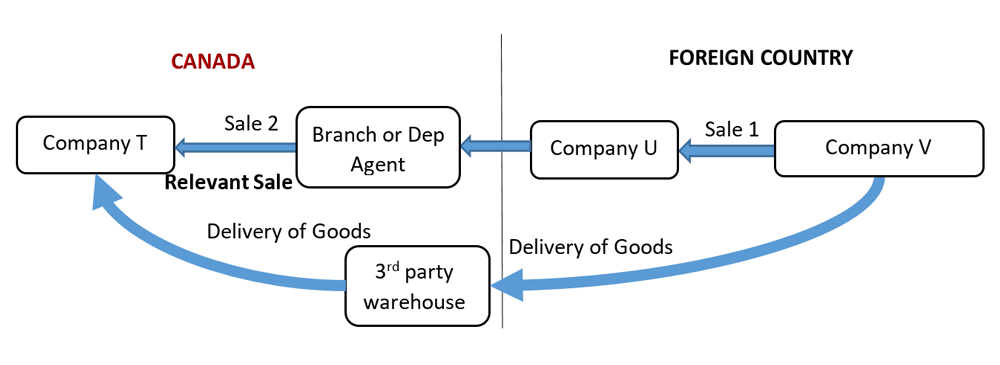
Company T, who is a resident in Canada, places an order with a company in a foreign country, company U, through its branch or dependent sales agent located in Canada. Company U contracts with another company in the foreign country, company V, to fill the order. The goods are shipped to company T in Canada through a third-party warehouse. In this case, the goods are the subject of two sales:
- sale 1: from company V to company U
and - sale 2: from company U, through its branch or dependent sales agent, to company T
The intercompany transfer from company U to its Canadian branch cannot be a sale as the branch is not a separate legal entity. Likewise, in the case of a dependent sales agent, although a separate legal entity, it does not purchase the goods on its own account. Correspondingly, as neither the branch nor the dependent sales agent is the entity purchasing the goods, it does not qualify as a permanent establishment for purposes of applying the transaction value method.
Both sales occur prior to importation. The sale from company V to company U does not involve a purchaser in Canada, as company U is a non-resident who has already sold the goods to company T, a resident in Canada. The sale from company U to company T is to a purchaser in Canada, as company T is a resident, and it is the sale that causes the goods to be exported to Canada. Therefore, it is considered the relevant sale for export to Canada and is to be used to determine the transaction value of the imported goods.
Example 9
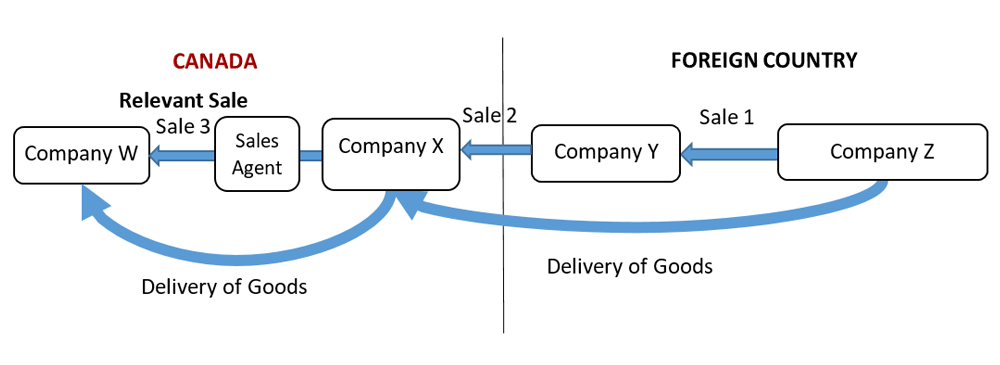
Company X is a non-resident located in Canada, who is responsible for delivery logistics within Canada, and is a wholly-owned subsidiary of company Y, who is located in a foreign country. Sales in Canada are solicited using sales agents.
In this case, the sales agent has obtained an order from company W, a resident in Canada, and the order is placed through company Y's computer system. Once the purchase order is accepted by company Y, two invoices are automatically generated: one from company X to company W and another from company Y to company X. Company Y then contracts with company Z, also located in the foreign country, to fill the order. The goods are shipped to company W through company X.
In this case, the goods are the subject of three possible sales:
- sale 1: from company Z to company Y
- sale 2: intercompany sale from company Y to company X
and - sale 3: from company X to company W
All sales occur prior to importation. The order from company W, sets off the chain of events that cause the goods to be exported to Canada.
Purchaser in Canada:
- company Y is a non-resident who has sold the goods to a person in Canada and, as such, does not qualify as a purchaser in Canada;
- company X has a fixed place of business, but is not carrying on business in Canada as the purchaser of the goods (i.e. it does not purchase and sell the goods on its own account) through the fixed place of business. Rather, company X is responsible for the delivery of the goods and acts on the authority of company Y. As such, it does not qualify as a purchaser in Canada.
- company W qualifies as a purchaser in Canada as they are a resident and have ordered and purchased the goods on their own account.
The purchase order made by company W, followed by the acceptance of the order by company Y and the issuance of the invoice to company W, even if in company X's name, is considered as the sale for export.
Therefore, it is sale 3, from company X to company W, on the authority of company Y, that is considered the relevant sale for export to Canada to a purchaser in Canada and is to be used to determine the transaction value of the imported goods.
Page details
- Date modified: